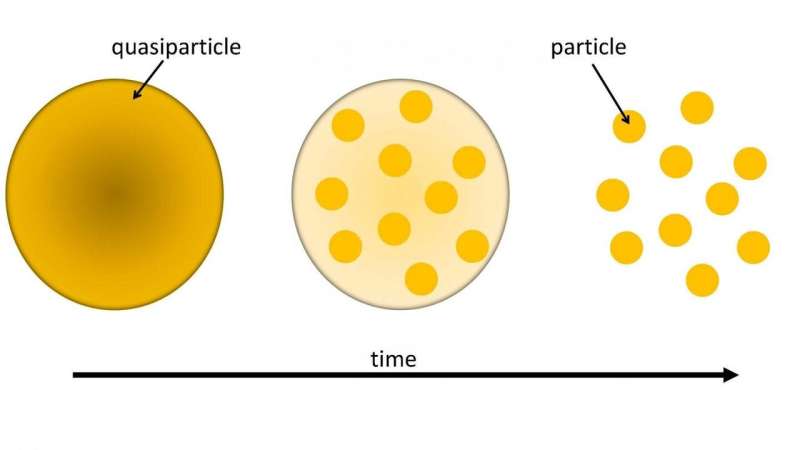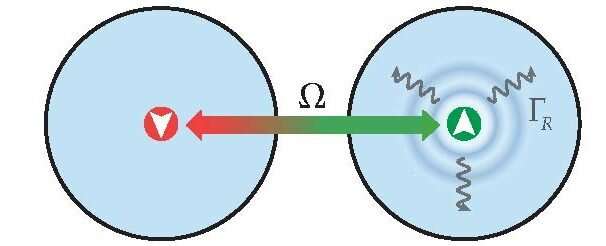Over time, many-body dephasing kills the quasiparticle's resemblance to a single particle. Credit: FLEET
In large systems of interacting particles in quantum mechanics, an intriguing phenomenon often emerges: groups of particles begin to behave like single particles. Physicists refer to such groups of particles as 'quasiparticles'.
Understanding the properties of quasiparticles may be key to comprehending, and eventually controlling, technologically important quantum effects like superconductivity and superfluidity.
Unfortunately, quasiparticles are only useful while they live. It is thus particularly unfortunate that many quasiparticles die young, lasting far, far less than a second.
The authors of a new Monash University-led study published today in Physical Review Letters investigate the crucial question: how do quasiparticles die?
Beyond the usual suspect—quasiparticle decay into lower energy states—the authors identify a new culprit: many-body dephasing.
Many Body Dephasing
Many-body dephasing is the disordering of the constituent particles in the quasiparticle that occurs naturally over time.
As the disorder increases, the quasiparticle's resemblance to a single particle fades. Eventually, the inescapable effect of many-body dephasing kills the quasiparticle.
Far from a negligible effect, the authors demonstrate that many-body dephasing can even dominate over other forms of quasiparticle death.
This is shown through investigations of a particularly 'clean' quasiparticle—an impurity in an ultracold atomic gas—where the authors find strong evidence of many-body dephasing in past experimental results.
Two spin states (red and green) of an impurity embedded in a Fermi sea (blue) are coupled together and undergo Rabi oscillations with an effective frequency ? and damping rate ΓR. The damping rate is dominated by many-body dephasing. Credit: FLEET
The authors focus on the case where the ultracold atomic gas is a Fermi sea. An impurity in a Fermi sea gives rise to a quasiparticle known as the repulsive Fermi polaron.
The repulsive Fermi polaron is a highly complicated quasiparticle and has a history of eluding both experimental and theoretical studies.
Through extensive simulations and new theory, the authors show that an established experimental protocol—Rabi oscillations between impurity spin states—exhibits the effects of many-body dephasing in the repulsive Fermi polaron.
These previously unrecognized results provide strong evidence that many-body dephasing is fundamental to the nature of quasiparticles.
The study was led by the School of Physics and Astronomy, Monash University, with co-authors from the Istituto Nazionale di Ottica del Consiglio Nazionale delle Ricerche in Florence, Italy, and Ludwig-Maximilians-Universität in Munich, Germany.
More information: Haydn S. Adlong et al, Quasiparticle Lifetime of the Repulsive Fermi Polaron, Physical Review Letters (2020). DOI: 10.1103/PhysRevLett.125.133401
Journal information: Physical Review Letters
Provided by FLEET

























